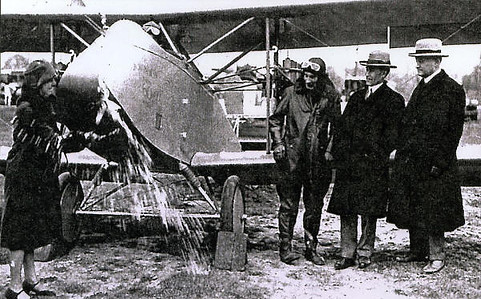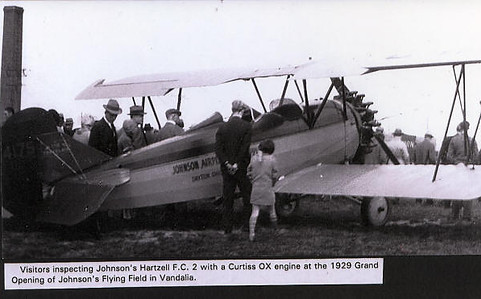.png)
Al Johnson Flying Field
• Edward Albert Johnson was born on January 14th, 1885 in Newport, Rhode Island.
• Father : Christian Frederick Johnson & Mother : Alice Anderson Johnson came to the United States from Copenhagen, Denmark in 1870 and settled in Rhode Island.
• They moved to Oakland, California where Al received his public school education and the attended Polytechnic Business College in that city.
• Al was president / owner of Motor Express & Drayage Company of Oakland from 1911 until 1915.
• Al learned to fly and was trained at airfields in San Diego, California and Buffalo, New York where he studied flying under Walter Lees.
• Edward Albert Johnson first soloed in 1915 and received Pilot License No. 32.
• In 1915 Al became a representative of The Curtiss Aeroplane & Motor Company in England.
• He returned to the U.S. in 1916 and was engaged as a civilian flight Instructor and test pilot for the Curtiss School / US. Army in Mineola, N.Y. and Ellington Field in Houston, Texas
• Later in 1917, employed as a flight instructor at McCook Field in Dayton, Ohio, Al met Jimmie Johnson (no relation) and they became life long friends and business associates. Their work continued at McCook Field, under Washington Bureau of Military Aeronautics, Chief Colonel Thurman Blake until 1918.
Exhibits & Galleries
Buildings

• In 1919, following the W.W.I , Al joined the U.S. Post Service, laying out 'Air Mail routes' from New York to Chicago. Al Johnson was one of the group of pilots who flew that momentous opening day route from New York to Chicago.
• In late 1919, Al organized The Johnson Airplane & Supply Company which was the leased facility on Ludlow Street in Dayton, Ohio. There he sold aircraft parts, performed aviation related manufacturing. Two planes that Al designed were assembled in this facility. They were the 'DL-V ; a single place, monoplane powered by a Henderson motorcycle engine, that subsequently won the 1924 Air Races, held in Dayton, Ohio. And in the 'Johnson Twin Sixty1 dual-wing, twin engine airplanes were also built at this South Ludlow Street location beginning in 1927.
• In 1921 Al was able obtain the necessary funds to begin the operation of a small air field on Wilmington Pike, South of Dayton, Ohio. Now know as the Defense Electronic Supply area.
• From this new location, he began carrying passengers, making air mail deliveries and charter flights. He also taught young aspiring pilots to fly. Through 1927, he was proud to report that there was never a fatality while operating his flying service at this location. He also operated an aircraft supply business out of this location, including the sale of used planes, engines and accessories. Some of which were manufactured at his Ludlow Street location.
• In early 1926, the business leaders surrounding Al Johnson's Wilmington Pike airfield, encouraged Al Johnson to seek larger, more remote facilities. Apparently, complaints about the noise of the aircraft, as well as a concern over the fear of crashes and the safety of local residents caused this action. Plus, the lease agreement on this property, (with the Hartzell Corp. of Piqua, Ohio) would expire in 1927.
• Al proceeded to take several aerial surveys of Dayton and the surrounding area and ultimately chose a large open area 10 miles North of Dayton, very near the small village of Vandalia, Ohio. The 310 acres were purchased by The Dayton Airport Corporation, which consisted of local businessmen.
• In 1926 the initial 'clearing of the fields' for 3 runways begins.
• In 1927 Johnson's Airplane & Supply Company - The company also manufactured Johnson's newly patented the 'brakes' for airplanes, selling the patent to Bendix Corp. in 1929. - Bill Conover then came to work for Al to Vandalia, where they collaborated on the now famous Canary airplane. - Also in 1929 Johnson designed, built and attached the first 'tail wheel1 assembly onto an airplane. - Al also 'personally' designed the Johnson 'Air Speed Indicator1 and 'The AVIGO Compass1 .
• In 1927 the new airfield property was leased to The Johnson Airplane & Supply Co. for $9000.00 / year and ultimately consisted of the following : - 2 hangers - a brick office/machine center building. Still standing this is referred to as the Lear building. - a water tower - a small brick power plant building. - A Refiners Oil and Gasoline automobile filling station w/ a yellow, Ivan Driggs 'Bumble Bee' Monoplane mounted on the roof for advertising and promotional purposes. - The flying Field (take-off and landing) consisted of 3 Macadam surfaced runways that were 75 feet wide and 500 feet long. The 3 converging runways, pointing West, as an arrow point, away from the 2 adjacent hangers. - The 3 families living on or near the airfield, inhabited 3 older, existing farm dwellings that were within walking distance of the airfield.
• On October 11th,1928 an early morning fire originated in one of the hangers. This was a major set back for Al Johnson and the new airfield. Al and The Dayton Flying field each lost 4 airplanes. Property damage including the hanger and the 8 airplanes amounted to $35,000.00. This tragedy delayed the Grand Opening Presentation until the summer of 1929. The field was ready for operation at a total cost of $187,300.00.
• The 'depression' caused further financial strife for the young struggling airport.
• In 1934, the government took over all Air Mail transportation. The cancellation of 'Civilian Air Mail' contracts was more than Johnson could financially endure and he closed his flying service once and for all in 1934. But according to the records, remained president of The Johnson Airplane & Supply Company until 1939.
• 1948... Al Johnson was a true pioneer of aviation. Al was a charter member of the Institute of Aeronautical Sciences and The Early Birds. He was also a member of the National Aeronautical Association, the Aero Club of America, the Quiet Birdmen, The Dayton Flying Club and The Engineers Club of Dayton.
• He was generous and caring, but most of all "he was one hell of a pilot". It is ironic that after all those years of his daring and dangerous career , his life would end in 1948 at the young age of 63, in an automobile accident. They assume that he experienced a heart attack at the wheel, causing him to lose control of his car. His car hit a concrete structure of an overpass in Del Mar , California. He was alone and died from injuries of the accident.



.png)

